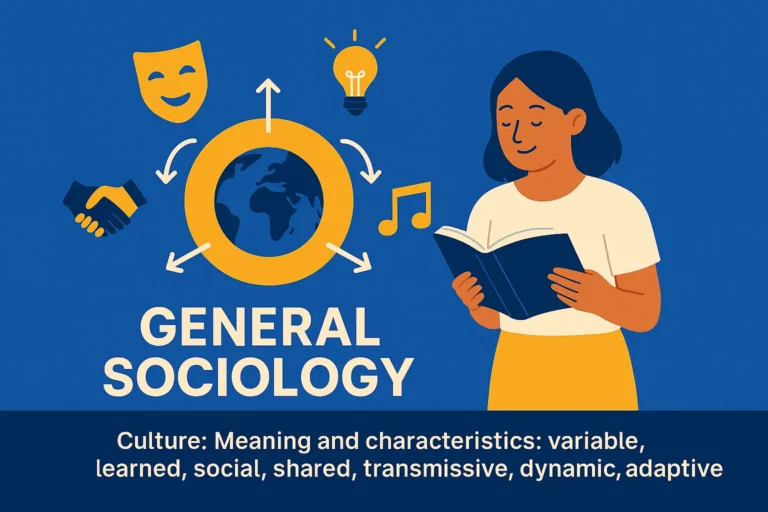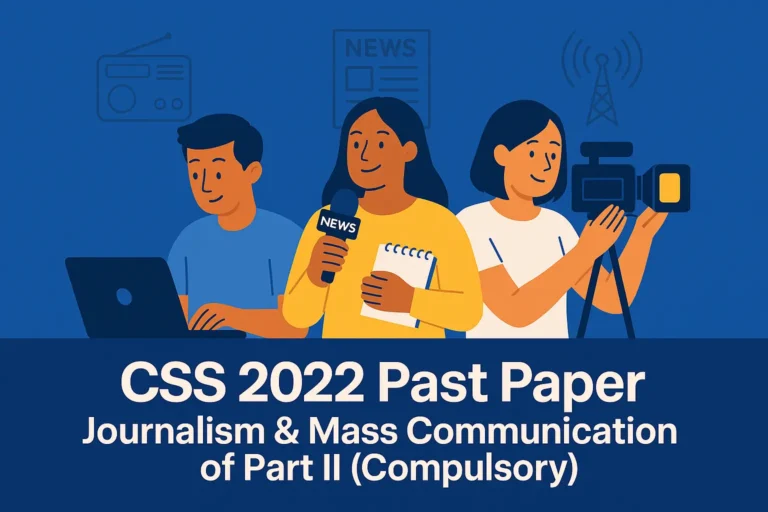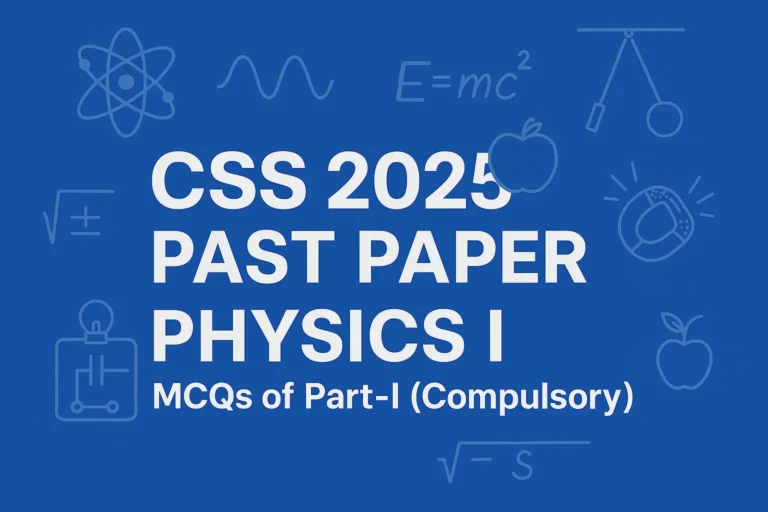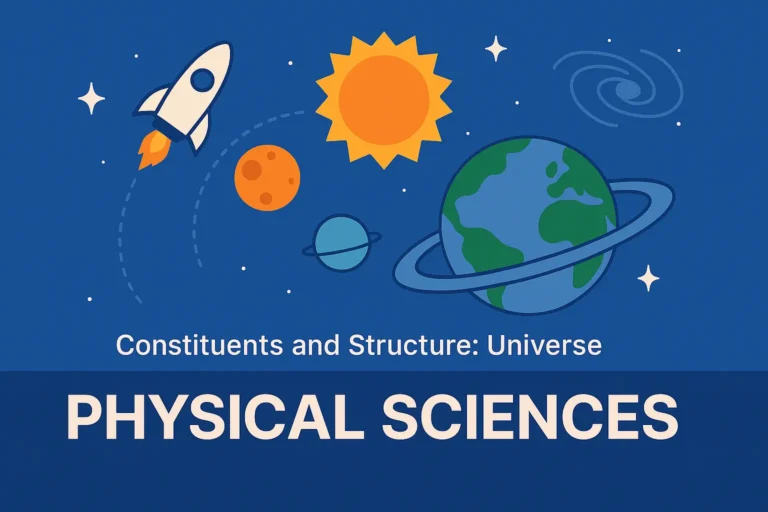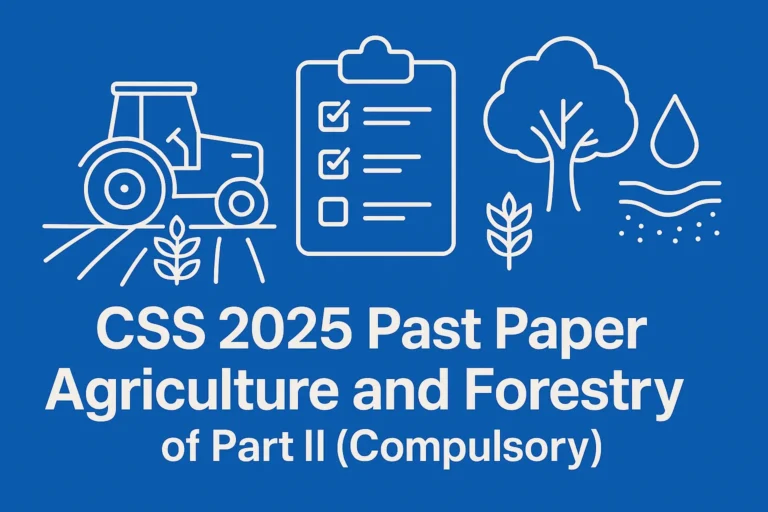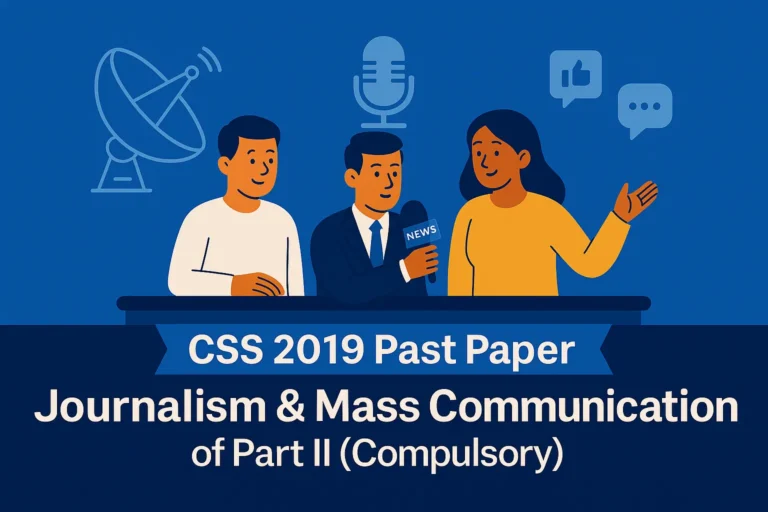CSS 2025 Solved Past Paper – Public Administration Part-II (Compulsory)
Below is the solution to PART-II (COMPULSORY) of the CSS 2025 Public Administration Paper.
Question 2
Discuss the core values of Public Administration. Also write a detailed analysis on the following:
a. Concept of Traditional Public Administration.
b. Concept of New Public Management.
Introduction
Public Administration exists to convert public will into workable results. Its touchstone is not profit but public interest, delivered lawfully, fairly, efficiently, and transparently. Below, I first lay out the core values that guide administrators, then explain how two major paradigms, Traditional Public Administration and New Public Management, seek to realise those values in practice.
Core Values of Public Administration
- Rule of Law
Decisions must flow from duly enacted laws and rules, not personal whims. This guards citizens against arbitrariness and gives administrators clear procedural boundaries. - Public Interest & Stewardship
Officials are custodians of public resources. Every rupee, file, and facility is held in trust for citizens, prioritising social welfare over private gain. - Accountability & Answerability
Multiple controls, parliamentary oversight, audits, courts, and media ensure administrators can explain and justify actions and face consequences for wrongdoing. - Transparency
Openness in procedures (publishing criteria, bids, and reasons) builds trust and deters corruption. Proactive disclosure shortens the citizen–state information gap. - Equity & Social Justice
Services should reach all, especially marginalised groups, without discrimination. Equity turns legality into lived fairness (e.g., merit-based recruitment with quotas where constitutionally provided). - Integrity & Ethical Conduct
Honesty, impartiality, avoidance of conflicts of interest, and zero tolerance for graft are non-negotiable. Codes of conduct operationalise this value. - Responsiveness & Timeliness
A citizen’s time is public money. Quick, empathetic responses (time limits, one-window facilitation, helplines) make the state feel present and reliable. - Efficiency & Effectiveness
Use minimal inputs to achieve intended outcomes (value-for-money). It includes process simplification, digitisation, and performance tracking. - Participation & Inclusiveness
Consulting stakeholders, through hearings, local councils, and e-participation, improves policy quality and legitimacy. - Professionalism & Neutrality
Merit-based recruitment, continuous training, and non-partisanship ensure stable service delivery across political cycles. - Service Orientation (“Citizen-as-Client”)
A courteous, problem-solving mindset, SOPs that start with “How can we help?”, translates institutional values into everyday behaviour at the counter.
a. Concept of Traditional Public Administration (TPA)
Intellectual roots: Woodrow Wilson’s politics–administration dichotomy and Max Weber’s model bureaucracy.
Core idea: A hierarchical, rule-bound, process-oriented machinery that executes laws impartially.
Key Features
- Hierarchy & Unity of Command: Clear lines from minister to secretary to field office; each post has defined authority.
- Formal Rules & Procedures: Predictable, uniform treatment; files move through prescribed channels to curb arbitrariness.
- Division of Labour & Specialisation: Standardised tasks to build expertise and consistency.
- Merit-based, Career Civil Service: Recruitment by exams; tenure ensures continuity and neutrality.
- Input/Process Emphasis: Compliance and propriety checks (notes on file, sanctions, audits) dominate.
Strengths
- Ensures legality, consistency, and fairness, critical in tax, policing, regulation, and justice.
- Provides institutional memory and stability across political changes.
Limitations (why reform debates began)
- Red tape and slow service due to excessive process compliance.
- Producer-centred culture: the system’s convenience can eclipse citizen convenience.
- Weak incentives for innovation and results; success is often measured by the procedure followed, not outcomes achieved.
Where TPA still fits best
Core sovereign functions (law & order, taxation, justice, regulation, national security) where the rule of law and due process must dominate.
b. Concept of New Public Management (NPM)
Context: From the 1980s (notably UK, New Zealand), fiscal stress and citizen expectations pushed governments to “manage” like high-performing organisations.
Core idea: Bring managerialism, market-style mechanisms, and performance incentives into the public sector to improve efficiency and service quality.
Key Features
- Results/Performance Orientation: Clear KPIs, targets, and output/outcome budgeting; “what gets measured gets managed”.
- Decentralisation & Autonomy: Empower front-line managers (financial and HR flexibilities) with accountability for results.
- Customer Focus: Map citizen journeys; set service standards, feedback loops, grievance redressal, and service charters.
- Competition & Contracting-out: Use PPPs, outsourcing, or internal competition where appropriate to lower costs and raise quality.
- Lean Processes & Digitalisation: Re-engineer workflows; reduce steps, queues, and forms; adopt e-government platforms.
Strengths
- Improves efficiency, responsiveness, and innovation in service delivery (licensing, utilities, e-services).
- Allows for reward/penalty systems that are in line with results; makes performance visible.
Critiques & Cautions
- If the state is overly “marketised”, accountability may become fragmented (many contractors, unclear responsibility).
- There is a risk of goal displacement if only easily quantifiable targets are important; challenging social outcomes could be overlooked.
- Due process must take precedence over speed in core coercive/regulatory domains; NPM tools need to be carefully modified.
Where NPM fits best
Transactional services (registrations, payments, certificates, utilities, and health/education delivery arms), where time, cost, and quality are quantifiable and improvable, are the areas where NPM works best.
TPA vs NPM, A Quick Comparison
| Dimension | TPA (Classical) | NPM (Managerial) |
| Purpose focus | Process legality | Results & value |
| Structure | Hierarchy, central control | Decentralised, empowered units |
| Accountability | Upward (rules/audits) | Upward + outward (KPIs, citizens) |
| Citizen view | Subject of Administration | Customer/partner in service |
| Tools | Rules, files, inspections | KPIs, contracts, PPPs, e-gov, service charters |
| Risks | Red tape, inertia | Fragmentation, metric gaming |
Conclusion
An effective public sector blends both paradigms: TPA safeguards the rule of law, equity, and due process, while NPM injects efficiency, responsiveness, and innovation. Maintaining classical rigour in sovereign/regulatory functions while implementing NPM tools in service delivery, supported by robust transparency, citizen feedback, and digital governance, is the wise course of action for Pakistan. The enduring core values of public Administration are best served by that well-rounded strategy, which also satisfies contemporary demands for prompt, equitable, and accountable services.
Question 3
Explain the concept of Scientific Management. Also elucidate on:
a. Network Governance.
b. Public Choice Theory.
Introduction
The 20th century saw Administration evolve from rigid bureaucratic systems toward more scientific, participatory, and citizen-centred approaches. This evolution is demonstrated by three major paradigms: Public Choice Theory (an economics-inspired, citizen-as-consumer approach), Scientific Management (an efficiency-focused approach), and Network Governance (a collaboration-focused approach). When taken as a whole, they represent separate but related discipline milestones.
Concept of Scientific Management
Origin: Developed by Frederick Winslow Taylor (1911), known as the “Father of Scientific Management”.
Core Idea: To maximise efficiency, substitute scientifically researched and standardised procedures for “rule-of-thumb” work methods.
Key Principles
- Scientific Job Design: Break tasks into the smallest units (time–motion studies).
- Standardisation: Uniform tools, methods, and training for predictable results.
- Selection & Training: Choose workers scientifically; train them systematically.
- Cooperation: Harmonious relations between management and workers to align incentives.
- Performance-based Rewards: A Differential wage system to encourage higher productivity.
Strengths
- Boosted industrial efficiency, output, and discipline.
- Provided measurable, replicable methods of task management.
Criticisms
- Reduced workers to “cogs in the machine”.
- Overemphasis on efficiency at the cost of creativity, motivation, and human dignity.
- Ill-suited for complex, knowledge-intensive public services.
Relevance in Public Administration:
Still visible in work study cells, performance audits, one-window service desks, and digitisation drives, all attempts to make public offices more efficient and standardised.
a. Network Governance
Definition: A governance model emphasising inter-organisational coordination among state, private, and civil society actors to address complex policy problems.
Key Features
- Horizontal Collaboration: Multiple actors (ministries, NGOs, donors, local governments, tech platforms) interact as partners.
- Flexibility & Adaptability: Looser, non-hierarchical structures compared to Weberian bureaucracy.
- Shared Resources & Knowledge: Each actor contributes strengths (finance, expertise, legitimacy, technology).
- Trust & Reciprocity: Relationships, not just rules, bind the network.
Examples
- Pakistan’s Polio Eradication Initiative, UNICEF, WHO, provincial governments, and local health workers coordinate in a vast governance network.
- Disaster Management (NDMA + NGOs + armed forces + communities) relies heavily on collaborative networks.
Strengths
- Tackles “wicked problems” (climate change, pandemics) that no single actor can handle.
- Encourages innovation and citizen involvement.
Limitations
- Diffused accountability (“who is responsible?” becomes unclear).
- Power imbalances, stronger actors may dominate the network.
- High reliance on trust, which may erode in fragile political contexts.
b. Public Choice Theory
Definition: Application of economic principles to political/administrative decision-making, developed by James Buchanan and Gordon Tullock. Citizens, politicians, and bureaucrats are seen as self-interested actors rather than purely public-spirited.
Core Assumptions
- Politicians maximise votes.
- Bureaucrats seek larger budgets, perks, and job security.
- Voters pursue policies that maximise their personal benefit.
- Outcomes result from the aggregation of these interests.
Policy Implications
- Need for checks and balances to prevent bureaucratic expansion.
- Decentralisation and competition (e.g., local government vs central) improve efficiency.
- Privatisation & contracting-out as remedies to the monopoly power of state departments.
- Citizen as Consumer: Service delivery should follow consumer choice principles.
Criticism
- Overly cynical; neglects altruism and public service motivation.
- Risks of reducing governance to a marketplace, ignoring broader values like equity and justice.
Relevance in Pakistan
- Public Choice explains why subsidies linger (vote-seeking politicians), why bureaucracies expand (budget-maximisation), and why rent-seeking persists.
- Reforms like the Right to Information Acts, independent regulatory bodies, and e-government platforms align with Public Choice recommendations to curb discretion and empower citizens.
Comparative Lens
| Dimension | Scientific Management | Network Governance | Public Choice Theory |
| Focus | Efficiency (work optimisation) | Collaboration (multi-actor governance) | Incentives (self-interest in politics) |
| Unit of Analysis | Worker & task | Inter-organisational relationships | Politicians, bureaucrats, voters |
| Mechanism | Standardisation, training, monitoring | Trust, partnerships, coordination | Incentive structures, competition |
| Risk | Dehumanisation | Accountability gaps | Excessive cynicism |
Conclusion
The three concepts are not mutually exclusive but complementary. Scientific Management stresses efficiency in micro-level tasks; Network Governance highlights collaborative capacity at the macro level; and Public Choice Theory cautions against unchecked self-interest in institutions. For Pakistan, a balanced adoption, scientific tools for efficiency, network models for service delivery, and Public Choice-inspired accountability safeguards can strengthen public Administration in both performance and legitimacy.
Question 4
Explain Policy Analysis and Evaluation. Furthermore, elaborate:
a. Policy analysis process in Public Administration.
b. Areas of improvement in Policy Implementation in Pakistan.
Introduction
Public policy is the backbone of governance; it translates the political vision of leaders into actionable programmes. However, policies are only as good as the analysis that informs them and the evaluation that measures their success. In Pakistan, weak analysis and poor implementation often reduce well-intentioned policies to paper promises. Therefore, policy analysis and evaluation are vital instruments to bridge the gap between policy intent and policy outcomes.
Policy Analysis
Definition: The methodical process of analysing public issues, evaluating potential fixes, and suggesting the best course of action is known as policy analysis.
Purpose
- Identify what problem needs solving (agenda-setting).
- Evaluate alternative solutions based on evidence.
- Provide decision-makers with actionable advice that balances efficiency, equity, political feasibility, and administrative practicality.
Key Dimensions
- Problem Definition – framing the issue correctly (e.g., “youth unemployment” vs “skills mismatch”).
- Evidence Gathering – collecting statistics, surveys, comparative data.
- Option Appraisal – cost–benefit analysis, stakeholder analysis, risk assessment.
- Recommendation – clear, practical advice tailored to decision-makers’ constraints.
Policy Evaluation
Definition: Evaluation measures how well a policy achieves its objectives, and whether its benefits justify its costs.
Types of Evaluation
- Ex-ante (before implementation): predicts feasibility, cost, and impact.
- Mid-term (during implementation): provides feedback for course correction.
- Ex-post (after implementation): checks effectiveness, efficiency, equity, and sustainability.
Benefits
- Ensures accountability.
- Prevents resource wastage.
- Creates a feedback loop for better future policymaking.
a. Policy Analysis Process in Public Administration
The process generally unfolds in five interlinked stages:
- Agenda Setting
- Public problems gain attention through the media, civil society, or political pressure.
- Example: Climate-related floods brought environmental policy to the national agenda.
- Policy Formulation
- Experts, ministries, and think tanks draft proposals; options are debated and narrowed.
- Tools: Cost-benefit analysis, forecasting, simulation models.
- Decision Making
- Political authorities (cabinet, parliament) choose among alternatives.
- Here, feasibility and political acceptability often outweigh technical optimality.
- Implementation
- Bureaucratic machinery translates decisions into actions (programmes, schemes, regulations).
- Involves coordination across ministries, provinces, and local governments.
- Evaluation & Feedback
- Continuous monitoring and final evaluation highlight gaps, successes, and unintended outcomes.
- Lessons feed into the next policy cycle, making it iterative.
b. Areas of Improvement in Policy Implementation in Pakistan
- Strengthening Institutional Capacity
- Many policies fail due to weak bureaucracy, overlapping mandates, and poor coordination.
- Capacity-building, merit-based recruitment, and digital governance can address this.
- Reducing Political Interference
- Frequent policy reversals occur due to regime changes.
- Strong parliamentary committees and bipartisan consensus on key issues (education, energy, climate) are needed.
- Improving Federal–Provincial Coordination
- After the 18th Amendment, subjects like health and education were devolved. Lack of coordination between federal and provincial units confuses.
- Clear demarcation of roles and resource-sharing frameworks can reduce conflicts.
- Ensuring Adequate Funding & Resource Allocation
- Many schemes remain underfunded.
- Linking budgets to performance indicators (output-based budgeting) is essential.
- Enhancing Monitoring & Evaluation (M&E)
- Weak M&E culture leads to poor accountability.
- Independent evaluation units, citizen report cards, and real-time dashboards can help.
- Curbing Corruption & Leakages
- Patronage networks often capture public schemes.
- Stronger procurement systems, e-procurement platforms, and third-party audits can reduce leakages.
- Citizen Participation & Ownership
- Policies designed without stakeholder input face resistance.
- Public hearings, social audits, and participatory budgeting can improve ownership.
- Leveraging Technology
- E-governance, GIS mapping, and digital feedback apps can make implementation faster, more transparent, and citizen-friendly.
Conclusion
Policy analysis and evaluation ensure that governance is evidence-based, transparent, and accountable. In Pakistan, the gap between policy design and implementation remains wide due to institutional, political, and resource-related challenges. Strengthening analytical capacity, coordination mechanisms, and monitoring frameworks, while fostering citizen engagement, is essential to turn policies into meaningful outcomes. In short, Pakistan needs to move from a policy-rich but implementation-poor state toward one that delivers tangible benefits to its citizens.
Question 5
Explain the principles of budgeting. In the same context, explain:
a. Line-item Budging.
b. Performance Budging.
Introduction
A budget is the financial reflection of government policy; it translates political priorities into resource allocations. In Public Administration, budgeting is not just about accounting; it is a tool for economic management, governance, and accountability. Sound budgeting ensures fiscal discipline, allocates resources strategically, and promotes transparency in how public money is spent.
Principles of Budgeting
Budgeting in the public sector is guided by universally accepted principles, which ensure that it serves as a rational, transparent, and effective management tool.
- Comprehensiveness: All revenues and expenditures must be included in a single budget to avoid hidden funds or “off-budget” accounts. It gives a complete financial picture of government activity.
- Unity: There should be a single budget document, ensuring that priorities across ministries are weighed together. Separate, fragmented budgets weaken fiscal control.
- Annuality: Budgets are typically prepared for one fiscal year, allowing periodic review and legislative oversight. Long-term projects may be spread across years but broken into annual allocations.
- Universality: Gross budgeting requires that both revenues and expenditures be shown without netting off. This principle prevents manipulation of figures.
- Specificity (Rule of Lapse): Funds must be spent only on their designated purpose. For example, money allocated for health cannot be diverted to defence. It ensures accountability.
- Balanced Budget Principle: Traditionally, expenditure should not exceed revenue. While deficit financing is sometimes necessary, it must be carefully justified and controlled.
- Flexibility vs. Control: Budgets must balance strict control (to avoid misuse) with some flexibility for administrators to respond to unforeseen circumstances.
- Transparency & Accountability: Budgets should be published, debated, and open to audit. Citizens should know how their taxes are being spent.
- Efficiency & Economy: Resource allocations should seek maximum output for minimum input. This principle justifies reforms like performance-based budgeting and e-procurement.
- Participation: Modern budgeting emphasises citizen engagement, consultations with stakeholders, and legislative debate to ensure legitimacy and inclusiveness.
a. Line-Item Budgeting
Definition
Line-item budgeting is the oldest and most widely used form of public budgeting. Expenditures are classified into detailed categories (salaries, equipment, fuel, stationery, etc.), each known as a “line item”.
Key Characteristics
- Input-based: Focuses on what the government buys rather than what it achieves.
- High specificity: Each item is listed separately, making monitoring easy.
- Emphasis on control: Prevents misuse of funds since money must be spent on its assigned item.
Strengths
- Simplicity: Easy to prepare and understand.
- Strong control: Legislatures and auditors can easily check whether funds were spent as allocated.
- Accountability for inputs: Misuse of funds can be quickly identified.
Weaknesses
- Ignores outcomes: Spending is judged by whether it followed allocations, not whether it achieved results.
- Inflexibility: Cannot easily reallocate money if circumstances change.
- Encourages incrementalism: Next year’s budget is often just last year’s plus a little more.
Example in Pakistan
Provincial health department budgets often list line items like:
- Rs. 10 million for medicines
- Rs. 5 million for machinery
- Rs. 2 million for transport
While easy to track, such budgets rarely ask if these expenditures actually improved health outcomes.
b. Performance Budgeting
Definition
Performance budgeting emerged as a reform to overcome the weaknesses of line-item budgets. It links financial allocations to measurable results, emphasising outcomes rather than just inputs.
Key Characteristics
- Output and outcome focus: Funds are tied to specific targets (e.g., literacy rate increase, kilometres of roads built).
- Performance indicators: Uses benchmarks, KPIs, and targets to measure success.
- Flexibility: Managers get more autonomy in spending as long as they deliver results.
Strengths
- Promotes efficiency: Money is spent where it generates the greatest impact.
- Encourages accountability for results, not just compliance with rules.
- Facilitates evaluation and feedback loops.
Weaknesses
- Requires strong data systems, which many developing countries lack.
- Performance indicators can be manipulated or chosen poorly.
- Can be resisted by bureaucracies accustomed to input-based control.
Example in Pakistan
In education, a performance budget might allocate:
- Rs. 500 million to raise literacy rate from 58% to 65% in three years.
- Progress is tracked through student enrollment, dropout reduction, and exam pass rates.
Unlike line-item budgets, this model asks: Did the spending achieve better education outcomes?
Comparative View
| Dimension | Line-item Budgeting | Performance Budgeting |
| Focus | Inputs (how money is spent) | Outputs & outcomes (results of spending) |
| Control | Strong, rigid | Flexible, with accountability through results |
| Simplicity | Very easy to prepare | Complex, needs strong monitoring |
| Accountability | Compliance with allocations | Achievement of goals |
| Relevance | Best for ensuring legal & financial control | Best for ensuring efficiency & effectiveness |
Conclusion
Both models reflect different phases of budgeting evolution. Line-item budgeting is simple and control-oriented but outdated for modern governance needs. Performance budgeting, though challenging in developing states, is essential to ensure that scarce resources translate into meaningful results for citizens.
For Pakistan, a hybrid model is ideal: maintain line-item discipline for financial control in sensitive areas, while gradually expanding performance budgeting in social sectors (education, health, poverty alleviation). This blend would ensure both fiscal prudence and developmental effectiveness.
Question 6
Public Employment in Pakistan has been facing challenges since ages, as it hinges between Spoil System and Merit System. In the above context, elaborate:
a. Open system of public employment.
b. Close system of public employment.
Introduction
Since civil servants convert policies into services, public employment forms the foundation of the state apparatus. But in Pakistan, professionalism (based on merit) and patronage (based on the spoils system) have long been at odds over public employment. This conflict establishes the bureaucracy’s effectiveness, impartiality, and legitimacy. It is crucial to look at two opposing models, the open system of employment and the close system of employment, to comprehend these difficulties.
Historical Context: Spoils vs Merit in Pakistan
- Spoils System: This system, which dates back to 19th-century American politics, enables political leaders to designate devoted supporters to public positions. In Pakistan, jobs have frequently been given out as political rewards, particularly under unstable regimes.
- Merit System: It is promoted by the provincial PSCs and the Federal Public Service Commission (FPSC), where competitive tests and credentials determine hiring.
Pakistan’s public employment system has oscillated between these two extremes: meritocracy is attempted to be maintained by constitutional protections, but political influence frequently distorts recruitment.
a. Open System of Public Employment
Definition
All eligible citizens can apply for public positions in an open system through open, competitive procedures. Merit-based, external recruitment is used to choose the best applicants.
Key Features
- Equality of Opportunity: All citizens fulfilling the minimum criteria may apply.
- Merit-based Selection: Exams, interviews, and tests form the basis of recruitment.
- Transparency: Advertisements in newspapers/portals ensure wide participation.
- Mobility: People can enter and exit the system more easily.
Advantages
- Promotes fairness and equal opportunity.
- Brings in fresh talent and new ideas from society.
- Enhances legitimacy and trust in institutions.
- Reduces nepotism and favouritism.
Disadvantages
- Frequent inflow may dilute institutional memory.
- The possibility of brain drain exists if gifted people think public service is unappealing because of the lack of incentives.
- Those with preparation resources may do better on competitive exams.
Example in Pakistan
One well-known illustration of an open system is the Central Superior Services (CSS) exam. Any citizen who satisfies the requirements can take the test and, if qualified, be placed in Grade 17.
b. Close System of Public Employment
Definition
Recruitment is restricted to those working within the bureaucracy in a close system. Promotions and appointments are made internally; jobs are not available to outsiders. Open competition is frequently subordinated to seniority, loyalty, and tenure.
Key Features
- Internal Mobility: Employees move up the ladder within the organisation.
- Limited Access: Outsiders rarely join at higher levels.
- Seniority-based Promotion: Stability and continuity are valued more than fresh talent.
- Security of Tenure: Employees enjoy long careers with guaranteed progression.
Advantages
- Builds institutional loyalty and stability.
- Preserves institutional knowledge and culture.
- Reduces disruptions caused by frequent external entrants.
Disadvantages
- May breed complacency, inefficiency, and favouritism.
- Reduces competition, thereby discouraging innovation.
- Can entrench political patronage if insiders are rewarded based on loyalty rather than performance.
Example in Pakistan
In many provincial bureaucracies, there is little lateral entry, and junior clerks advance to senior positions over decades. Although this offers stability, it occasionally excludes external candidates with exceptional skills.
Comparative Lens
| Aspect | Open System | Close System |
| Access | Open to all citizens | Restricted to insiders |
| Basis of Recruitment | Merit exams, open competition | Seniority, tenure, loyalty |
| Innovation | Bring new ideas from outside | Limited innovation, continuity-focused |
| Transparency | Higher, due to public competition | Lower, often opaque |
| Risk | Brain drain, exam inequality | Nepotism, inefficiency, and lack of accountability |
| Example in Pakistan | CSS/FPSC recruitments | Provincial department promotions |
Pakistan’s Challenge: Between Spoils and Merit
- Spoils Dimension: Merit is undermined by political regimes’ frequent meddling in hiring, transfers, and postings.
- Merit Safeguards: FPSC and judicial oversight exist but are weakened by political influence.
- Hybrid Reality: Pakistan uses open entry at junior/entry levels (CSS, PCS exams), but promotions and higher appointments often resemble a closed system, marred by favouritism.
Conclusion
An effective public employment framework for Pakistan requires balancing open and close systems. The open system ensures fresh, merit-based recruitment, while the close system ensures career continuity and institutional memory. However, both must be insulated from spoils politics. Strengthening the FPSC, digitising recruitment, enforcing performance-based promotions, and protecting bureaucracy from political pressure are essential reforms. Only then can Pakistan achieve a truly professional and merit-based public service.
Question 7
What do you understand by delegation of authority and legislation? Explain the following in the same context:
a. Principles of effective delegation of authority.
b. Steps in the process of delegation.
Introduction
Modern organisations, public or private, cannot function if all decisions are centralised. In Public Administration, where ministries and departments handle vast tasks, delegation of authority is essential to ensure efficiency. Simultaneously, legislation provides the legal framework that defines the scope and limits of such delegation. Together, they ensure both operational flexibility and accountability to the law.
Delegation of Authority
Delegation is the transfer of decision-making power from higher levels of management to subordinates, while overall responsibility remains with the superior. It is not abandonment of authority but sharing of responsibility for effective functioning.
Key Elements of Delegation
- Assignment of Duties: Specifying what is to be done.
- Granting of Authority: Empowering subordinates with the right to act.
- Creating Accountability: Ensuring the subordinate answers for performance.
Importance in Public Administration
- Reduces the workload of top officials.
- Ensures quicker decisions at the field/operational level.
- Develops leadership and capacity among subordinates.
- Increases efficiency and citizen responsiveness.
Legislation in this Context
Legislation provides the legal boundaries within which delegation operates. For example:
- A minister may delegate day-to-day tasks to a secretary, but only within the limits defined by laws passed by Parliament.
- Rules of Business in Pakistan specify which matters require cabinet approval and which can be delegated.
Thus, delegation without legislative backing risks illegality, while legislation without delegation creates bottlenecks.
a. Principles of Effective Delegation of Authority
- Principle of Functional Clarity
Duties, authority, and responsibilities must be clearly defined to avoid confusion. - Principle of Unity of Command
Each subordinate should receive orders from one superior only to maintain discipline and accountability. - Principle of Proper Communication
Delegated authority should be communicated in clear, written form so subordinates know their scope. - Principle of Competence
Authority must be delegated to individuals with the requisite skills and capacity to perform the tasks. - Principle of Adequate Authority
Authority given should match responsibility; one cannot be held accountable without sufficient power. - Principle of Accountability
Responsibility ultimately rests with the superior, even after delegation. Accountability should be clear and enforceable. - Principle of Balance
Balance must exist between delegation and control; excessive delegation may weaken central authority, while under-delegation creates inefficiency. - Principle of Results Orientation
Delegation should focus on achieving outcomes rather than rigid processes.
b. Steps in the Process of Delegation
- Defining the Task
The superior identifies tasks that can be delegated (routine, operational, or technical matters). - Assigning Duties
Subordinates are clearly told what work is expected, with timelines and performance standards. - Granting Authority
Subordinates are empowered with the rights and resources to carry out duties (e.g., financial approval limits). - Creating Responsibility & Accountability
Performance reporting mechanisms are established to ensure the subordinate is answerable. - Establishing Communication Channels
Effective upward and downward communication ensures coordination and problem-solving. - Providing Support & Guidance
Supervisors remain available for advice, training, and resources to facilitate delegated tasks. - Monitoring & Feedback
Regular supervision and feedback loops help identify problems early and ensure alignment with objectives. - Evaluation & Adjustment
Performance is reviewed; if delegation is ineffective, authority levels or responsibilities may be adjusted.
Practical Example in Pakistan
- The Prime Minister delegates authority to cabinet ministers, who further delegate operational powers to secretaries and additional secretaries.
- In taxation, the Federal Board of Revenue (FBR) delegates assessment powers to commissioners and deputy commissioners, while strategic policy remains centralised.
- All such delegation is enabled under legislation (e.g., Income Tax Ordinance, Rules of Business, Civil Servants Act) which defines limits of authority.
Conclusion
Delegation of authority and legislation are two sides of effective governance. Delegation ensures administrative efficiency, timely service delivery, and leadership development, while legislation ensures that such delegation remains legal, accountable, and consistent with constitutional authority. In Pakistan, strengthening the delegation, through digital authority tracking, merit-based appointments, and training, within a solid legislative framework, can enhance both efficiency and the rule of law.
Question 8
What are the functions of district Government? Explain the following:
a. Issues of local government in Pakistan.
b. Post-Devolution local government challenges in Pakistan.
Introduction
Local government represents the third tier of governance, closest to the citizens. In Pakistan, district governments play a vital role in ensuring service delivery, promoting participatory democracy, and addressing local needs. However, the system has been unstable, frequently reshaped by constitutional amendments, political regimes, and administrative reforms. To understand its significance, one must look at the functions of district governments, the structural issues, and the post-devolution challenges following the 18th Constitutional Amendment.
Functions of District Government
The district government is the backbone of local governance in Pakistan. Its functions can be grouped into the following domains:
1. Administrative Functions
- Implementation of laws, rules, and government orders at the district level.
- Supervision of tehsil and union councils.
- Maintenance of law and order in coordination with the police and district administration.
2. Developmental Functions
- Planning and execution of development projects in roads, health, education, and water supply.
- Monitoring schools, hospitals, and other service delivery outlets.
- Promoting local economic development through markets and trade facilitation.
3. Regulatory Functions
- Licensing of businesses, shops, and services.
- Building regulations, sanitation, and waste management.
- Monitoring food quality, public health standards, and land use.
4. Financial Functions
- Collection of local taxes, fees, and charges (property tax, tolls, water charges).
- Budget preparation and expenditure at the district level.
- Coordination with provincial finance commissions for revenue sharing.
5. Social Welfare Functions
- Running social welfare programs for vulnerable groups (orphans, widows, and disabled people).
- Disaster management and emergency relief coordination.
6. Political & Democratic Functions
- Strengthening participatory governance by involving elected councillors.
- Serving as a training ground for grassroots political leadership.
- Acting as a channel between citizens and higher tiers of government.
a. Issues of Local Government in Pakistan
Local governments in Pakistan face persistent problems even though the constitution supports them:
- Political Instability
- Each regime redesigns the local government system to suit its political needs.
- Absence of continuity weakens institutional growth.
- Lack of Autonomy
- Provinces often control finances, transfers, and even the tenure of local bodies.
- District governments depend heavily on provincial grants.
- Resource Constraints
- Weak revenue generation at the local level.
- Heavy reliance on transfers limits flexibility and responsiveness.
- Capacity Deficits
- Many local councils lack skilled staff, planning expertise, and technical capacity.
- Training and professional development are inadequate.
- Corruption and Mismanagement
- Inadequate financial oversight, nepotism in appointments, and financial mismanagement lower efficiency.
- Citizen Disengagement
- Citizens often view local governments as ineffective due to poor performance.
- Weak participatory structures lead to low trust and minimal community ownership.
- Weak Judicial & Administrative Accountability
- Provincial oversight organisations and auditing institutions frequently fall short in enforcing compliance.
b. Post-Devolution Local Government Challenges in Pakistan
The provinces now have a great deal of authority to create and maintain local governments thanks to the 2010 18th Amendment to the Constitution. But this change brought with it new difficulties:
- Provincial Reluctance to Share Power
- The provinces treat local governments as administrative subordinates rather than independent entities, hesitating to transfer actual authority.
- Inconsistent Legal Frameworks
- Local government laws have been passed in various provinces (Punjab, Sindh, KP, and Balochistan), causing fragmentation.
- Resource Distribution Inequities
- Funds are frequently diverted for provincial priorities rather than local needs due to the weakness of provincial finance commissions.
- Frequent Dissolution of Local Bodies
- Local councils are prematurely dissolved by assemblies and provincial governments, leaving governance gaps.
- Overlap of Authority
- Inconsistency over decision-making authority between elected councils and district administration (police, deputy commissioners).
- Weak Political Will
- Federal and provincial political elites are concerned that strong local governments might challenge their hegemony.
- Lack of Integration with National Development Frameworks
- Local plans are frequently separated from provincial and national strategies, which weakens the coherence of policymaking.
Comparative Insight
| Aspect | Issues (General) | Post-Devolution Challenges |
| Level of Problem | Structural and systemic | Political and constitutional |
| Resource Base | Insufficient revenues | Unequal distribution among provinces |
| Autonomy | Already weak under the old systems | Further curtailed by provincial dominance |
| Accountability | Corruption, poor monitoring | Weak oversight after the 18th Amendment |
| Continuity | Frequent policy reversals | Institutional vacuum due to dissolved councils |
Conclusion
District governments are indispensable for bringing governance closer to people, ensuring responsive service delivery, and nurturing democratic participation. However, Pakistan’s local governments remain fragile due to political manipulation, resource constraints, and post-devolution ambiguities. To address this, Pakistan needs:
- A uniform constitutional framework for local government across provinces.
- Strengthened Provincial Finance Commissions to guarantee resources.
- Clear division of powers between provincial bureaucracy and elected councils.
- Investment in capacity building, technology, and citizen participation.
Only then can district governments transform from symbolic institutions into engines of grassroots governance and development.

